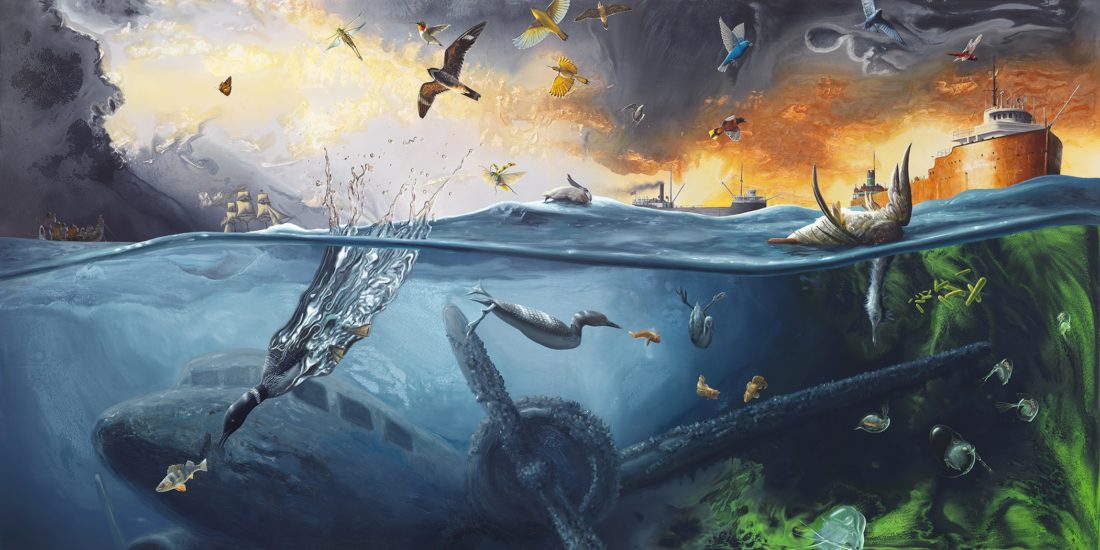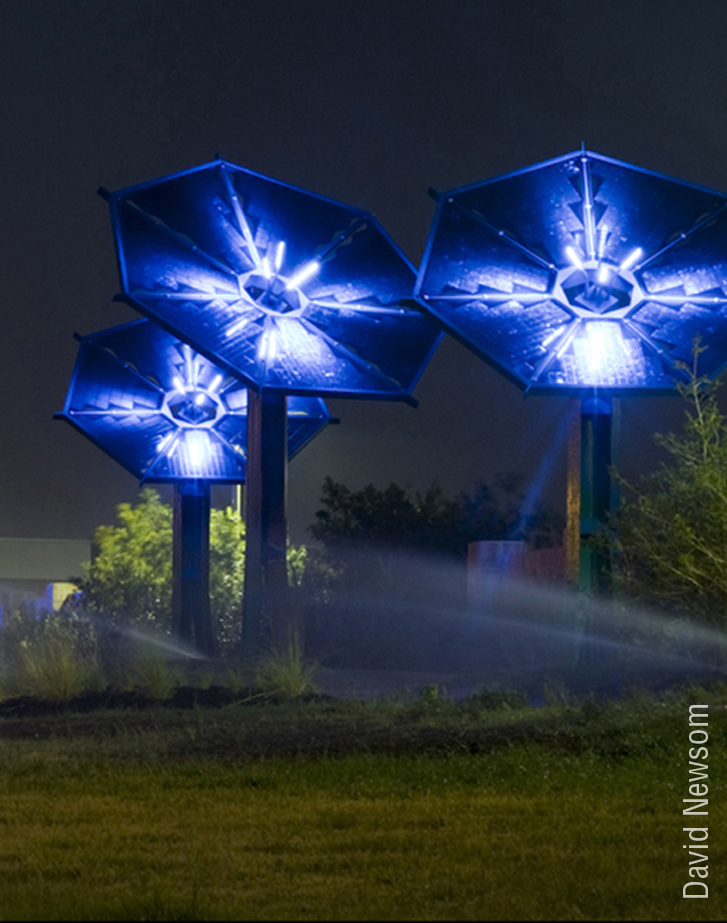Honoring the Future contributing artist Alexis Rockman is renowned for epic-scale paintings depicting the dystopian impacts of climate change, species extinction and eco-disasters. His most recent body of work – five years in the making – is now touring museums and galleries in Illinois, Michigan, Minnesota, Ohio and Wisconsin. Titled Alexis Rockman: The Great Lakes Cycle, the touring exhibition reflects Rockman’s passion for combining art and natural science to raise social and political awareness. He calls the result “journalism with a paint brush.”
Rockman began this initiative with a deep dive into natural science. In 2013, Michigan’s Grand Rapids Art Museum commissioned him to conduct a research tour of the Great Lakes, the world’s largest fresh surface water system, and to show how the lakes have changed over time.

Alexis Rockman, Spheres of Influence (2016). Oil and alkyd on wood panel. Dimensions: 72” x 144”. Collection of Jonathan O’Hara Gallery. © 2016, Alexis Rockman. Courtesy of the artist.
Harnessing the power of paint, watercolor and mixed media with drama and dexterity, Rockman’s Great Lakes Cycle explores the past, present and future of the Great Lakes. The highlight of the exhibition is Rockman’s suite of five mural-sized (6 feet x 12 feet) oil, alkyd and acrylic paintings exploring themes he identified during his research tour. The paintings are accompanied by keys, which identify the species and objects referenced in the work.

Artist’s Key to the species and objects portrayed in his Spheres of Influence painting (above). © 2016, Alexis Rockman. Courtesy of the artist.
Six large-scale watercolors and 28 field drawings – monochromatic animal and plant studies made with mud, sand, coal, or leaves from the region – complete the exhibition. Collectively, the works illustrate the lakes’ ecological richness, their resilience in the face of human onslaughts, and the challenges they still face from climate change and human pollution.
The exhibition is especially timely. In October, 2017, a massive bloom of thick, bright green, musty smelling algae covered 700 square miles of Lake Erie, a drinking water source for almost 3 million people. The lake’s algae blooms have been getting larger since 2000 – and are expected to grow larger still with unchecked climate change. More severe storms can wash more nutrients from farmland into the lake, threatening algae levels that harm human health, impair drinking water, require beach closures, and hinder recreation.
The Great Lakes are a national treasure: they contain 95% of the U.S.’s surface freshwater, supply drinking water to 40 million people, and support a $7 billion fishing industry, a $10 billion tourism industry, 4.3 million recreational boats, and 200 rare plants and animals. Yet the Administration’s proposed 2018 federal budget would have slashed funding for the Great Lakes Restoration Initiative, which coordinates the efforts of 11 federal agencies to restore the Lakes in partnership with the region’s 8 states, 40 tribes, 2 Canadian provinces, and numerous municipalities and businesses. Strong bipartisan support in both the U.S. House and Senate saved this crucial funding for now, but the risks of continued complacency are clear. Indeed, the Administration’s proposed 2019 federal budget would terminate 90% of this program’s funding.
In this context, Rockman’s work is “a call to action,” said Dana Friis-Hansen, Director of the Grand Rapids Art Museum. Rockman agrees. “The people of today hold the power to ensure the vitality of the Great Lakes of tomorrow,” he warns. To ensure that message gets through to the public, Rockman is making himself available for workshops and lectures in the communities on the tour. And Northern Michigan University has developed an online multimedia electronic text/course for viewers to learn more about the images and ideas in the paintings.
The exhibition will premiere at the Grand Rapids Art Museum, January 27 – April 29, 2018, and then travel to the following venues:
- Chicago Cultural Center– June 2 through October 1, 2018
- Cleveland Museum of Contemporary Art – October 19, 2018 through January 27, 2019
- Haggerty Museum of Art, Marquette University, Milwaukee – February 8 through May 19, 2019
- Weisman Art Museum, University of Minnesota, Minneapolis – October 5, 2019 through January 5, 2020
- Flint Institute of Arts – May 9 through August 16, 2020
Read more about The Great Lakes Cycle exhibition here.


